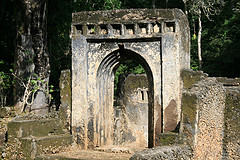The post-Lamu blues
“You’ve got the post-Lamu blues,” Wendy told me as we arrived, grumpily, in Malindi. And it was true. After a five-hour bus ride (which we discovered was much bumpier for the first three hours on an unpaved road when you’re sitting near the back of the bus), and then having to endure the touts upon arrival, we were naturally asking ourselves why in the world we had left our beautiful quasi-secret island town for this. But such is life when you’re an ambitious traveller and you have an $800 booking to see mountain gorillas 1800km away in less than two weeks – you always need to move on, sometimes earlier than you’d hoped.
We had only two more places we wanted to see on the Kenyan coast – the Marafa Depression and the Swahili ruins at Gede. To visit both places, we needed to stay at the beach resorts of Malindi and Watamu, the type of towns we would normally avoid like the plague. Watamu was at least somewhat pleasant (touts aside); we didn’t at all see the attraction of Malindi.
Meanwhile, Marafa was not as great as we had hoped. It was OK, but we’ve seen similar but immensely more impressive landscapes in places like Cappadocia and northwest Argentina, and, in Wendy’s case, the Grand Canyon. Given that it took us all day to get there and back from Malindi, including waiting for transport etc, it wasn’t worth the effort. In fact, the highlight of the day was being mistaken for Italians by all the local kids in the village near the Depression, as Malindi is extremely popular with Italians; having a five-year-old African kid in a one-street village in the middle of nowhere come up to you and say, “Ciao! Tutto bene?” is pretty surreal.
Our next stop was Gede, the most celebrated of the ruins on the Swahili coast. It was very atmospherically situated in a jungle landscape, with monkeys clambering on the ruins and in the nearby trees, but it again revealed a bit of jadedness on our part and the continuation of the post-Lamu blues, as it was certainly no Angkor or Tikal. The structures themselves were not particularly impressive and if it were not for the location, it would have been a disappointment.
To cure the post-Lamu blues, we knew we needed to get ourselves to the one place that could match up to Lamu: Zanzibar. After visiting Gede on Thursday morning, we travelled back to Mombasa in a matatu (a ubiquitous Kenyan minibus) and then hopped on a bus over the border to Tanga in Tanzania, which took 7.5 hours (LP had said 2). We arrived wearily in Tanga at 11:30pm and by 8:45am the next morning we were sitting on another bus bound for the Tanzanian capital Dar es Salaam. We arrived at 3:30pm at the bus station 8km from the town centre, and with 30 minutes left until the last ferry of the day, we went into Amazing Race mode. With the help of a taxi driver who fully invested himself in our ‘race’ – honking and screaming at other drivers who slowed us down, and getting rid of all the fake-ticket touts who descended on the taxi as we parked at the ticket office – we just made it. Two-and-a-half hours later, we arrived in Zanzibar after sundown on Friday, and the post-Lamu blues were over.
Tags: Africa, East Africa, Kenya


